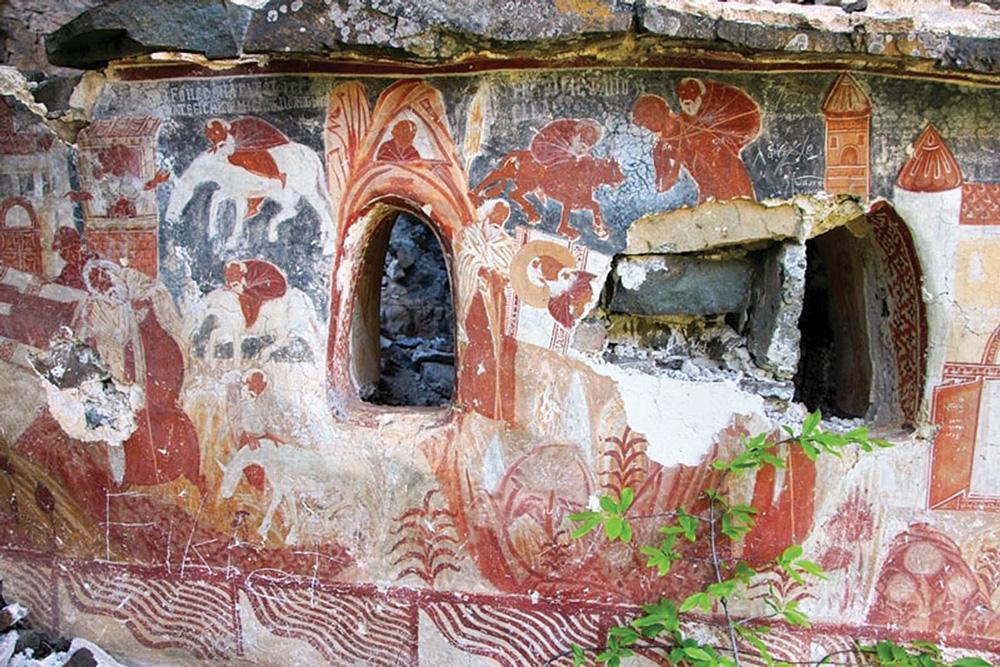
Two years of restoration works in the Sümela Monastery located in the northeastern province of Trabzon have unearthed a field in the upper right side of its northern roof.
The field, which is reached through a secret tunnel, is believed to have served as a temple or chapel for Christians.
Works have been continuing in the area, readying it to open to visitors.
One of the most important historic and touristic venues in Trabzon, the Sümela Monastery is located at the foot of the Karadağ Mount and is visited by 600,000 people on average every year. The monastery was closed two years ago to undergo restoration works.
As part of the restoration in the monastery, a special team of industrial mountaineers is working to prevent the masses of rock and ice from falling. The three-stage works aims to clean an area of 79,000 square meters.
It has been reported that the field is home to unseen frescoes depicting heaven and hell as well as life and death. The chapel is set to become a new destination for those interested in the history of the site.
A 30-meter road is planned to be constructed in the field. The damaged frescoes and roof sections will also be repaired.
Speaking about the issue, Provincial Culture and Tourism Director Ali Ayvazoğlu said visitors will be able to see the sections that have never been seen before.
“Once the restoration is finished, surprises will await our visitors here. They will have the chance to enter all the spots they have never visited before in the monastery. Without making the same mistakes in previous restorations, we will do more beautiful things using the current technology. The damaged parts of the frescoes are being repaired. We are also restoring the area, which served as a library in the past, on the right side of the monastery’s entrance. We will also have a different surprise but visitors will see it at the opening,” he said.
Ayvazoğlu believes that after the restoration, the monastery will woo more tourists not only to the religious site but also the region.
“When the Sümela Monastery closed to visitors in 2015, the number of tourists visiting the region fell. In 2016, the Hagia Varvara Church right next to the monastery was restored and the number of tourists coming to the region began increasing again. Those who were not able to enter Sümela photographed the Altındere Valley and the monastery from the terraces. They also visited the church. There was a 10-percent increase in the number of tourists compared to the figures of last year,” he added.
Koray Koçhan, the mayor of Maçka, said the Sümela Monastery is a symbol of Trabzon and Maçka, adding that it was also a religious center for the Orthodox world thanks to the rites held on Aug. 15.
Stating that the monastery had not been restored for many years, Koçhan said, “Rocks began falling from the mount around the monastery in the recent years. One night, a desk-sized rock fell on to the ticket windows. Luckily it happened at night, which prevented any casualties from happening. Then we began giving helmets to the visitors. Now the works aim at preventing the fall of the rocks and the restoration of the monastery. The cost of both works is 50 million Turkish Liras, fivefold of the annual budget of the municipality. Now there is a big mass of rock above the gate of the monastery and the restoration works are trying to prevent that from falling. When this work is done, certain parts of the monastery will reopen in July or August next year.”
Koçhan said the restoration will protect Sümela for the next 1,000 years.
“When the visitors come to the monastery, they used to see the church on the left of the entrance. But now there is an even older chapel, reached through a secret tunnel. There are many different frescoes here. They depict heaven and hell and life and death. One of the walls is intact and the frescoes are more authentic there. We anticipate that this place was built before the Sümela Monastery, when Christianity was not very popular. When all the work is done, visitors will be able to spend a whole day there,” he added.